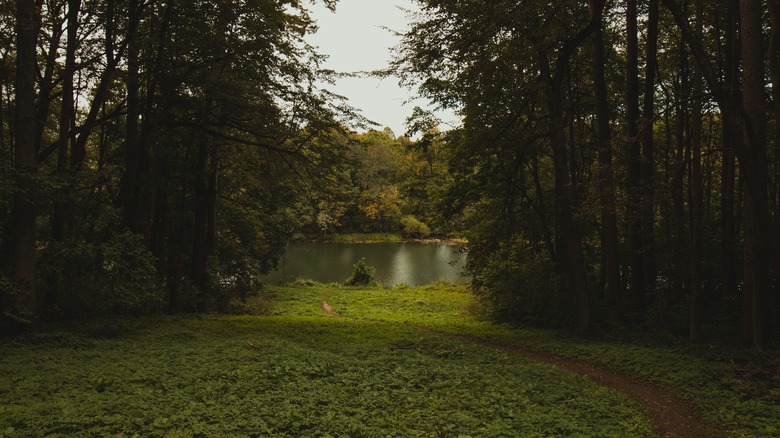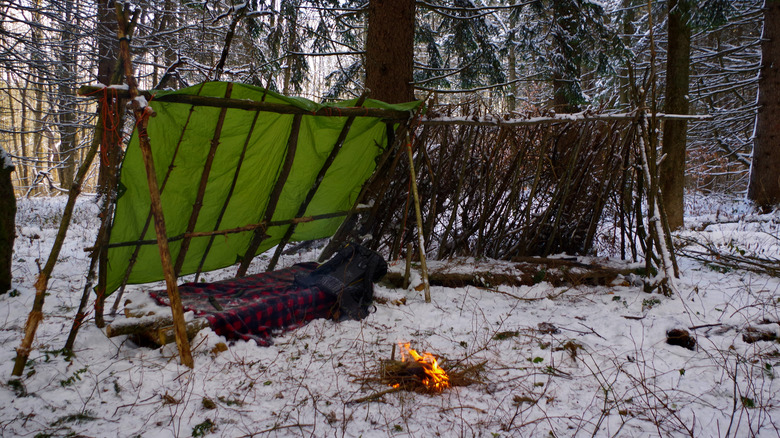Our Tips For Building A Safe Shelter If You Get Lost In The Woods
Before heading on an outdoor excursion, most people take care to pack an emergency gear bag. During their adventure, they also take precautions to prevent getting lost. However, despite preparation and precaution, thousands of people still get lost in the outdoors each year across the United States. According to National Geographic, the vast majority of those who get lost in the woods are day hikers who only expected to be on the trail for a few hours at most.
These day trippers are not just most likely to get lost, but they are also the most vulnerable to the elements. The reason for this is they are typically minimalists and only pack what they expect they need for their planned hike. This presents a problem if they become lost or are stranded due to weather conditions. Without materials to remain dry and warm or to build a shelter, they are in far more peril than someone who was well stocked for a longer excursion.
With that in mind, there are some things that survival experts recommend everyone who adventures in the woods to have with them at all times. One of the most important items is some sort of waterproof material that can be used to keep you dry and warm or even be used to build an improvised shelter. Good examples of something that could serve this purpose and still be very packable are a mylar thermal blanket, an emergency poncho, or even an industrial size trash bag. These items are small enough that they can be put in any pack or even a pocket. By utilizing items you have in your pack along with natural materials, you can build a safe shelter if you get lost in the woods.
Choose a good location to build your shelter
Once you have determined you will need to stay overnight — whether it be because you have become lost and don't have much daylight left or because unexpected bad weather has left you stranded – the first steps are to decide what type of shelter you need and to pick a good location to build your shelter.
The type of shelter you need to make it through the night will essentially be determined by the geographic region, prevailing weather, and time of year. If you are in a dry warm area, for instance, you won't need to worry much about waterproofing or insulation. If you are in a cold environment with snow or rain, you will need a shelter to help keep you both warm and dry. The needs for each geographic area can change based on the season and/or any weather systems moving through. It is always best to err on the side of caution and prepare for precipitation, wind, and cooler temperatures if there is any chance the weather could change overnight.
When it comes to picking a good location for your shelter, this isn't much different than any time you are looking for a suitable location to camp. The biggest difference is the amount of time you may have and your ability to move to a better site. For starters, do not build your shelter near any dead trees or loose or broken branches. If possible, try to find an area with a natural windbreak. Additionally, try to choose a spot near water, but make sure you are not in a spot that floods or is in an area that may fill during a flash flooding event. Finally, look for an area that has plenty of wood for both your shelter and fire.
Utilize whatever materials you have or can find
Once a site is selected, it is time to build your emergency shelter. The intricacy of your shelter will typically be determined by the amount of time you have, the elements you are needing shelter from, and the materials in your pack. If the amount of available daylight is dwindling or you are in a relatively mild, dry area, your build will likely be quick and simple. If you have more time or need more protection from weather, the task may take a bit longer.
If you happen to have some sort of waterproof material in your pack or emergency supply kit — such as a tarp or the aforementioned emergency blanket, poncho, or trash bag — that will be the cornerstone of your build. These materials can be rigged as a peaked tent by draping over a taut cord or low tree limb and tying or staking the sides. Similarly, a one-sided shelter can be quickly rigged by running a cord through one side of the material and staking the other side to the ground at roughly a 45-degree angle.
Natural materials can also be incorporated into your build. Limbs and branches can be utilized as tent poles and/or stakes. If you don't have any material with you to help with the build, you can also construct a shelter completely from natural materials. Limbs and brush can be leaned against a cliff, large rock, or tree. Limbs and branches can also be stacked together in a teepee configuration. Additionally, you can utilize any existing natural shelters, such as rock overhangs, caves, or large hollow logs, although take care not to build fire inside any of these structures.


